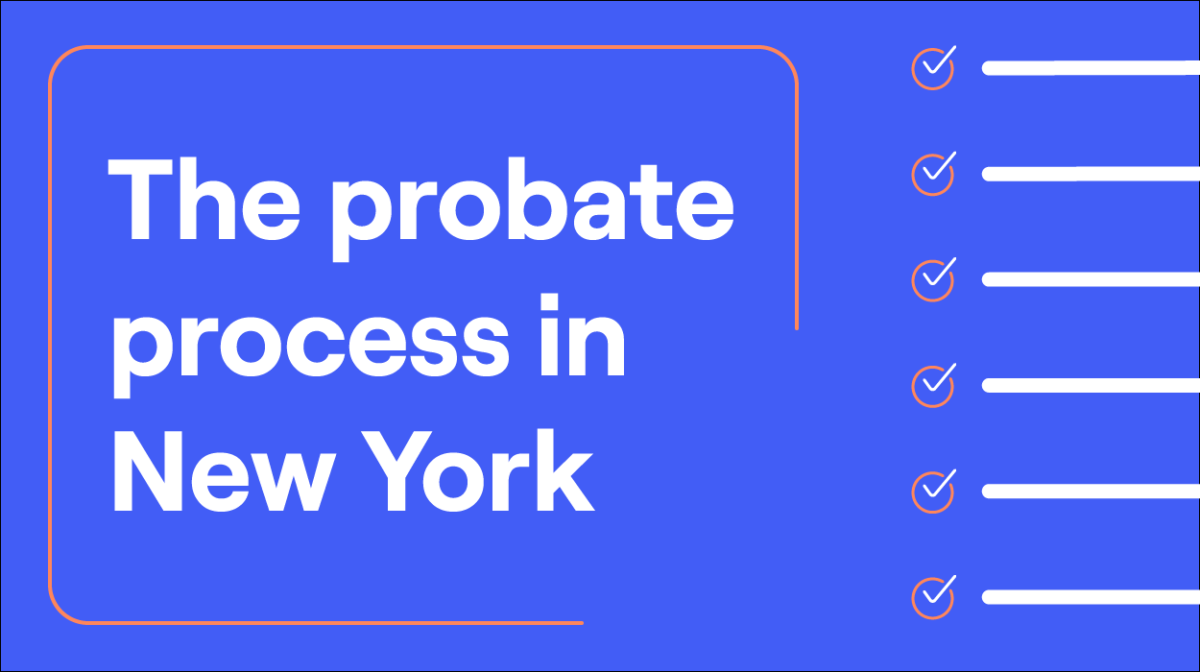Estate Settlement
May 01, 2025
What to Do When Someone Dies in California
Follow this step-by-step guide to navigate legal duties, probate, and estate tasks with clarity and confidence.
The probate process in New York can be confusing and lengthy. In this post, we walk you through the entire probate process in 7 simple stages.


The probate process entails the selection of an estate representative, who will then have the legal authority to act on the estate's behalf. The collection of the decedent's assets is the next step to probate, followed by the distribution of those assets to the appropriate parties.
We know how difficult probate may be, especially considering the circumstances, we’ve made it easier to understand and broken the process down into a simple 7-stage process. It should be noted that the probate process is also always a matter of public record.
There are multiple steps for the estate executor to follow during the probate process and they must all be followed precisely to adhere to probate laws. A probate attorney or estate planning attorney is not required but may help you to navigate any legal challenges.
OTHER NOTES OF INTEREST
The legal process in a New York State Surrogate's Court that secures the right to serve as an estate's fiduciary is a probate proceeding. However, an administration proceeding can also be undertaken instead.
If an estate is particularly small, there may be the option to go through the simple procedure of small estate administration, or voluntary administration, instead of the full probate. This, of course, depends on the deceased person's financial situation. Some people prepare estate plans and use estate planning techniques to try and avoid probate and simplify the process.
Being the estate executor carries a lot of responsibilities that will demand a lot of your time and effort, especially as it is usually only necessary as the result of a sad situation.
The death of a loved one is always hard, and dealing with their estate can be even more difficult. If you are an executor of an estate in New York, you may need to probate the will. This article will teach you how to do that.
The death of a loved one is always hard, and dealing with their estate can be even more difficult. If you are an executor of an estate in New York, you may need to probate the will.
Below, we have listed the steps to probate a will in New York;
Filing the petition for probate must be done in the county where the deceased was a resident on the day of their death. The original of the decedent's last will and testament, a copy of the death certificate, and the filing fee must be included with the petition for probate. Depending on the financial situation, more affidavits and supporting papers may be needed. Again, an estate attorney can help you with this if you feel it is necessary.
If a person leaves a will, their death is referred to as testate. The Surrogate's Court must be notified and the validity of their last will and testament must be proven. The New York probate procedure is how the Surrogate's Court approves a person's will and it gives a competent fiduciary the green light to administer that person's personal property.
A deceased person is considered to have died intestate if they pass away without leaving a last will and testament. Without a will, the deceased person leaves no one in charge of managing their affairs or estate. The decedent's family tree may be used in such cases to determine who the beneficiaries will be.
Notice of the probate action must be given to all essential parties. Any decree must be issued by the Surrogate's Court for it to have jurisdiction over certain interested parties. The people who must receive notice depend on the situation, but they almost always include the heirs at law, that is, those who would inherit even in the absence of a will.
Depending on the individual's connection to the decedent, a different type of notice may be necessary. Where these individuals live will determine how the notice is sent to them.
The primary goal of the probate process is to demonstrate the will's legitimacy⎯that it was lawfully completed, that it belonged to the dead, and that the decedent had the mental ability to make a will.
The petitioner must establish these conditions. It is important to ensure that the person who made the will had testamentary capacity at the time of its signing. Examining the will's witnesses under oath can be used to prove the will. However, if the testator and witnesses signed a self-proving affidavit, this investigation is frequently omitted.
This document includes a sworn declaration that confirms the legitimacy of the will. The petitioner could try acquiring a related affidavit from witnesses aware of the owner's death, provided that a credible statement is absent, in order to allow a waiver of the examination.
If the Surrogate's Court finds the will to be legitimate, it will give "letters testamentary" to the designated estate executor, appointing him as such and giving him a certificate of authority to gather the estate's assets, settle the estate's debts and taxes, and distribute the estate's assets to the beneficiaries specified in the will.
Preliminary letters testamentary may be issued by the Surrogate's Court if there are delays in a will's probate because the distributees are related or difficult to locate, or if a will challenge is anticipated.
In order to guarantee that the job is done correctly, the executor could be asked to submit a bond. Most wills have a provision that permits the executor to act without posting a bond, although on rare occasions, it may be necessary. The bond serves as insurance and will pay for any losses that the executor might suffer.
Once the Surrogate is satisfied that the will is valid, that the necessary parties have received enough notice, and that the proposed executor is qualified for the position, the Surrogate will issue a decree granting probate and allowing the issuance of the letters testamentary to the executor. The executor's capacity to act on behalf of the estate is confirmed by these letters testamentary.
In some cases, the executor is quite familiar with the deceased's assets. However, little may be known regarding the presence of assets in other circumstances. The assets of a probate estate can be determined using a variety of techniques.
The assets of the deceased must be listed by the probate estate administrator. The court must receive an asset list no later than six months from the appointment date or the deadline for filing an estate tax return, whichever comes first. An appraisal should be performed on real estate and occasionally other valuable goods.
If a beneficiary designation is present then the stated personal assets will pass to another person by operation of law. However, if the beneficiary is deceased, the personal assets will pass to one of the contingent beneficiaries.
Real estate with a title entirely in the decedent's name (including real estate investments), individually-held savings, checking, and brokerage accounts, cars, jewelry, money, and electronic equipment are a few examples of probate assets.
Any asset that lacks a beneficiary designate and does not pass automatically, falls within the definition of a probate asset. Indeed, real property owned solely in the decedent's name is referred to be probate property. However, any personal property that the deceased possessed jointly with another person (if the deed states "joint tenants") or for which she designated a beneficiary, passes automatically, without going through the probate process.
Certain assets are classed as non-probate assets and these can include a retirement account or retirement benefits, a life insurance policy with named beneficiaries, assets held in trust bank accounts with named beneficiaries, and any accounts held with joint ownership, e.g. joint bank accounts.
You must make payments to creditors before any distribution of assets to the beneficiaries, although partial distributions can sometimes be made. Credit card businesses and mortgage lenders are two examples of creditors. Debts shouldn't be paid off until it's been decided that the estate has enough money to pay for the funeral expense and any administration expenses. Priority is given to administration expenses and funeral expenses over all other debts.
The executor must also file a federal estate tax return for the deceased at this point and pay any estate taxes.
You must meticulously document every activity taken on the estate's behalf, including every expense. In addition to the fact that you must do this, heirs, creditors, or the court may occasionally raise queries or complaints. Your ability to answer for your activities is guaranteed if you keep accurate records.
Accounting is the last step in the probate process. Since they are nearing the finish line and the remaining assets are prepared to be distributed to the beneficiaries, executors are frequently relieved to reach this stage of the procedure. The executor is prepared to account once all assets have been gathered, all debts have been calculated, and all controversies have been settled.
Simply put, accounting is the executor's technique of documenting what has been received, what has been paid (including estate taxes and payments to creditors), and how the remaining assets should be dispersed. The executor needs the beneficiaries' approval of the account, as well as confirmation from the beneficiaries and creditors that they have received their just compensation.
Most estate settlements are informal and take place outside of court. The account is usually created by the executor's probate attorney and approved by each beneficiary. The beneficiaries are requested to sign a Receipt and Release, approving the account, attesting that they have received their entitlements, and absolving the executor of responsibility. In this case, the process is easier for people who are currently in a sad situation.
Some estates are resolved through a judicial accounting action for a variety of reasons (for example, an interested party cannot be traced or won't approve the executor's account). The first step in this procedure is the executor's petition, in which she requests that the court approve her account. It is necessary to give notice of the process to all beneficiaries, creditors, and other interested persons so that they have time to oppose it. The Surrogate has the authority to conduct a hearing to settle a disagreement. The Surrogate ultimately issues an accounting decree, which seals the account and absolves the executor of responsibility, all of which can be found in the probate records in public records.
The probate process can be daunting, but by following the seven simple steps we’ve outlined you can make it through with relative ease. Remember, if at any point you feel lost or need professional help, don’t hesitate to reach out for assistance. An estate planning professional will be more than happy to guide you through the process and answer any questions you may have. Thanks for following along, and good luck!

 Simplify Probate Today
Simplify Probate Today
Get expert guidance from our specialists who've helped 10,000+ families.
Book a free consultation